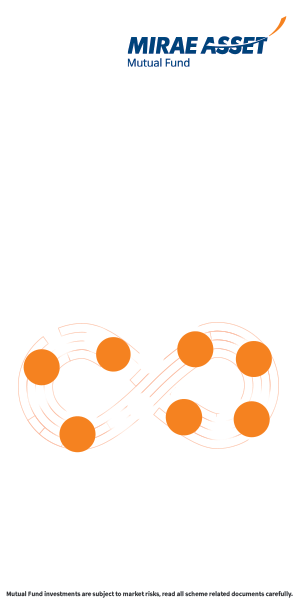Why is equity the best long term asset class

The Indian mutual fund industry has made great strides over the last few years with investors pumping in a record Rs 1.3 lakh Crores in equity mutual funds in 2017. However, the share of mutual fund assets in household savings is still very low in our country. As per RBI data, the share of mutual funds in financial assets is just 13%. If we include household savings in physical assets e.g. real estate, gold etc the share of mutual funds will be even lower. As far as household savings in financial assets are concerned, the preferred choice for families continue to be bank deposits, which account for nearly 50% of household financial assets.
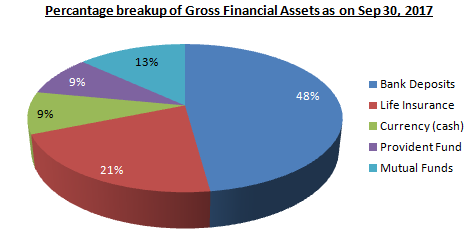
Source: RBI
You can see that savings in mutual funds is less than 30% of bank deposits; the corresponding figure in United States is somewhere in the region of 150%. Top 60 districts of India account for a vast share of the mutual fund industry AUM – if we exclude them, the penetration of mutual funds in household savings in the rest of the country is abysmally low. There are several reasons why mutual fund penetration is low in India. One of the main reasons is lack of financial awareness.
There are several misconceptions about equity investments in India even among people who have invested in mutual funds. We have stated ad nauseam in our blog that equity is the best performing asset class in the long term. The common refrain which we hear from some experienced stock market investors is that, “equity investing is all about luck” - you may have heard horror stories of how people lost lakhs or crores in the stock market.
In our view, luck comes into play if you are speculator and are trying to make a quick buck. If you invest in mutual funds in a disciplined manner with a long investment horizon, then luck is not a factor. Equity mutual funds invest in a diversified portfolio of stocks across different sectors, which diversify stock and sector specific risks. Over a long investment horizon, equity has outperformed debt, gold and other asset classes, creating wealth for investors.
Volatility and Risk
There is no doubt that equity is a volatile asset class. The stock market will rise and fall – this is known as volatility. However, investors should understand the difference between risk and volatility in relation to investment tenor. Risk is the probability of making a loss over your entire investment tenor. Over a long tenor your equity investment will rise and fall in value several times. From a risk perspective, however, we have to see whether the rise in up-markets is more than fall in down-markets. If your equity investment, generally, rises more in up-markets than it falls in down-markets, then the probability of making a loss over a long investment tenor is much lower and chances of wealth creation is that much higher.
In this blog post, we will discuss how equity performed against other asset classes over the last 5 years.
Performance of Equity versus other asset classes
Detractors say that we, in the online financial media, speak a lot about performance in good times and not so much about performance in bad times. We, in Advisorkhoj, always discuss equity mutual fund performance over long investment tenors, which include both good times (rallies) and bad times (corrections). To analyze equity performance versus other asset classes, we have taken a 5 year period (2014 to 2018 year to date) – this period covers different market conditions. 2014 was a bull market year with Lok Sabha elections and NDA coming to power. 2015 saw a correction in stock market globally, including India. 2016 began with a big fall in the first two months, followed by a recovery. 2017 was again a bull market. The first 3 months of 2018 saw a lot of volatility in the market and since then the market has been mostly sideways / range-bound so far.
Different asset classes
In this analysis, we have chosen BSE – 100 as the proxy for equities. BSE – 100 represents the large cap universe of stocks; large cap stocks account for the vast majority of total market capitalization in our stock markets. CRISIL Composite Bond Index is the proxy for short (1 to 3 years), medium (3 to 5 years) to long term (> 5 years) fixed income investment – this index is probably comparable to FDs of different tenors. CRISIL Liquid Fund Index is the proxy for very short term fixed investments (less than a year) – this index is comparable to savings bank. Finally, we also compare the different asset classes with Gold, another favorite asset class for Indians. Let us now see how the different asset classes performed in each of these years from 2014 to 2018 year to date.
Performance of different asset classes in 2014
As discussed earlier, 2014 was a bull market year – it began with the Modi wave leading up to the Lok Sabha elections. The market rallied with expectations of an NDA victory in the elections as indicated in the opinion polls leading up to the elections. Market rallied further, when NDA formed the Government. Let us now see, how other asset classes performed in 2014.
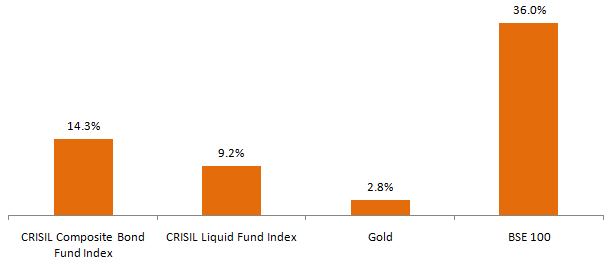
Source: CRISIL, BSE, Goldprice.org
You can see that all asset classes, except Gold, performed well in 2014, but BSE – 100 (equity) was the standout performer. Historical data analysis shows that Gold has a negative correlation with equity. Gold failed to beat inflation in 2014, but let us see if Gold outperformed when equity underperformed.
Performance of different asset classes in 2015
2015 began spectacularly for equities but we had a big correction in March and stock market was very volatile for the rest of the year with a downward bias, driven mainly by global concerns which included slowdown in China and fears of impending rate hike in the US. Let us see how different asset classes performed in 2015.
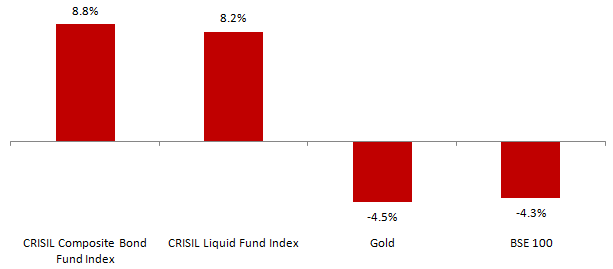
Source: CRISIL, BSE, Goldprice.org
Equity, unsurprisingly under-performed in such market conditions, but did equity underperformance wipe out the gains made in 2014 versus other asset classes? No it did not. If we combine the performance of 2014 and 2015, equity was still the best performer. Gold underperformed equity even in 2015.
Performance of different asset classes in 2016
The first two months of 2016 were brutal for equity, driven mainly by concerns of global economic slowdown on the back of falling crude oil prices. But the stock market recovered in March and continued its recovery for the rest of the year. In July 2016, we had the Brexit scare, which investors feared would cause meltdown in global equity markets, but no such thing happened – the market recovered the losses and ended flat in 2016. Let us see how different asset classes performed in 2016.
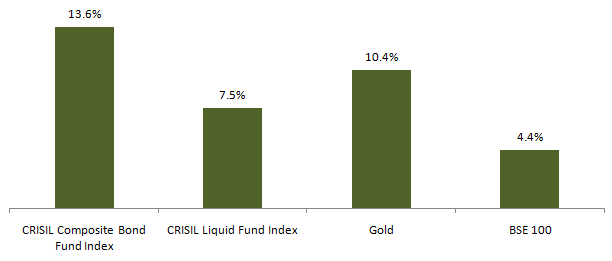
Source: CRISIL, BSE, Goldprice.org
Fixed income and Gold were outperformers and equity was the underperformer. But the losses made in 2015 by equities were, to a large extent, recovered by the end of 2016. If we look at the performances of different asset classes, point to point from 2014 to 2016, equity was still the best performing asset class. Gold was the worst performing asset.
Performance of different asset classes in 2017
Many of our regular readers will know that 2017 was a terrific year for the stock market, despite the lingering effects of demonetization and disruption caused by GST roll-out. After 2 years of underperformance BSE – 100 gave more than 30% returns in 2017 and was the standout outperformer. Let us see how other asset classes performed in 2017.
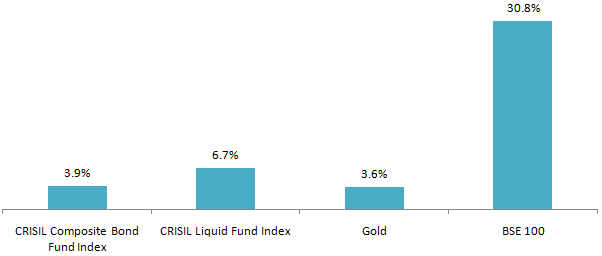
Source: CRISIL, BSE, Goldprice.org
We had discussed earlier that stock markets rise and fall – equity outperforms in up-markets and underperforms in down-markets. Does the quantum of outperformance in up-market compensate for the underperformance in down market? We had seen above that the equity’s outperformance in 2014 more than compensated in underperformance in 2015 and 2016. The superlative outperformance by equity in 2017, widened the performance gap vis-a- vis other asset classes even further.
Performance of different asset classes in 2018
2018, as many investors know, saw a lot of volatility and the market has been range-bound over the last few months. Let us how different asset classes have performed so far this year.
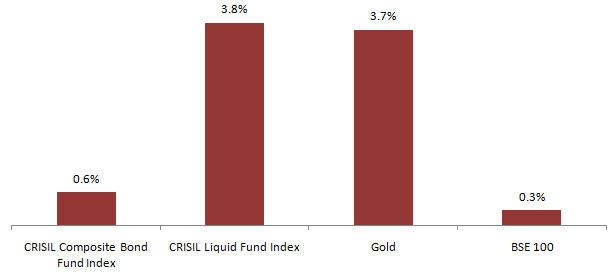
Source: CRISIL, BSE, Goldprice.org
Equity is the worst performing asset class this year (2018), but equities outperformance over the 2014 to 2017 period ensures that equity continues to be the best performing asset class over the entire period. As discussed several times before, the outperformance of equity in up-markets more than makes up for the underperformance in down-markets, making equity the best performing asset class over a long investment tenor. The chart below shows the performance of different asset classes from 2014 to 2018 YTD.
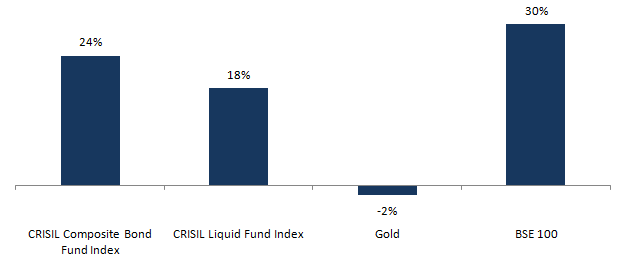
Source: CRISIL, BSE, Goldprice.org
Equity versus Real Estate
Any discussion on asset class choices in our country will not be complete without a discussion on real estate, the favorite asset class for many Indians, at least till a few years back. The biggest problem with real estate as an asset class is that there is no organized and regulated secondary market. Unlike equity and the other asset classes, where price discovery takes place in the exchanges through bidding, publicly available information and risk management processes, real estate deals take place through face to face negotiations between the buyer and seller. Lack of information may put one of the parties at serious disadvantage about the fair price. This makes real estate the riskiest asset class in India. As per some surveys, property prices have crashed 20% or more in some locations across the country in the last 5 years and prices are stagnant in many other locations.
Real estate is also one of the most illiquid asset classes. Possessions of some properties have been delayed by builders for more than 10 years, while buyers continue to pay interest on their home loans. An illiquid asset is the worst nightmare for investors. Large numbers of home-owners are stuck in litigations against their builders in the courts and cases are sub judice in various courts across the country, including the Supreme Court. Many builders are on the brink of bankruptcy and there is little hope of recovery of the investors’ capital without the courts’ or Government’s intervention. In the current scenario, we cannot even compare equity and real estate. Real estate, by and large across the country, is the worst performing asset class in the last 5 years.
Large Cap Equity versus Mid / Small Cap
Mid and small cap stocks and mutual funds were the investor favorites for the last few years. Raging investor interest in these stocks and funds caused valuations to sky-rocket – midcap stocks were trading at a huge premium to large cap stocks, while the opposite is generally the convention. Midcap and small cap stocks have fallen 13 – 15% in 2018. Though mid / small cap stocks and funds have the potential to give high returns in the long term, they are much more volatile than large cap stocks and funds. Large cap funds will provide stability to your investment portfolio and as such, these funds should comprise the core of your portfolio.
Indiabulls Large Cap Fund
Indiabulls Bluechip Fund has consistently outperformed both the benchmark Nifty and the large cap funds category returns over the last 3 years (please see our chart below). It is one of the top performing large cap funds in the last 3 years.
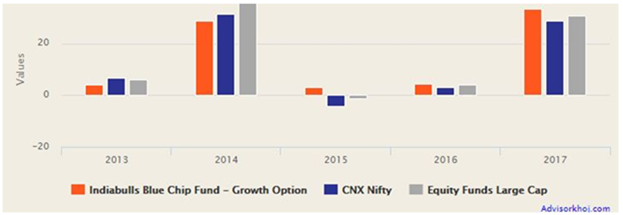
Source: Advisorkhoj Research
The chart below shows the growth of Rs 1 lakh lump sum investment in Indiabulls Bluechip over the last 3 years. Indiabulls Blue Chip Fund has also beaten the CRISIL AMFI Large Cap Index in Financial Year 2017-18.

Source: Advisorkhoj Research
You can see in the table below that, you would have made a profit of nearly Rs 39,000 on an investment of Rs 1 lakh in Indiabulls Blue Chip Fund over the last three years, outperforming the market.

Source: Advisorkhoj Research
Conclusion
In this blog post, we have discussed how equity is the best performing asset class in the long term. Even though equity is volatile, you are likely to get much higher capital appreciation and returns compared to other asset classes. Equity is also the most tax friendly asset class. Short term capital gains (investments held for less than a year) are taxed at 15%, while long term capital gains (investments held for more than a year) up to Rs 1 lakh are tax free. Long term capital gains in excess of Rs 1 lakh are taxed at 10%. Equity is the ideal asset class for your long term financial goals like retirement planning, children’s education, marriage and wealth creation for your family.
Mutual Fund Investments are subject to market risk, read all scheme related documents carefully.
Queries
-
What is the benefit of mutual fund STP
Aug 29, 2019
-
How much to invest to meet target amount of Rs 2 Crores
Aug 26, 2019
-
Can I achieve my financial goals with my current mutual fund investments
Aug 24, 2019
-
Can you tell me return of various indices
Aug 19, 2019
-
What would be the post tax return on different investments
Aug 18, 2019
-
Which Principal Mutual Fund scheme will be suitable for my retirement corpus
Aug 16, 2019
-
What is the minimum holding period for availing NCD interest
Aug 4, 2019
Top Performing Mutual Funds
Recommended Reading
Fund News
-
Bandhan Mutual Fund launches Bandhan Silver ETF FOF
Jan 12, 2026 by Advisorkhoj Team
-
Bandhan Mutual Fund launches Bandhan Gold ETF FOF
Jan 12, 2026 by Advisorkhoj Team
-
The Wealth Company Mutual Fund launches The Wealth Company Gold ETF FOF
Jan 9, 2026 by Advisorkhoj Team
-
Mahindra Manulife Mutual Fund launches Mahindra Manulife Innovation Opportunities Fund
Jan 9, 2026 by Advisorkhoj Team
-
Jio BlackRock Mutual Fund launches Jio BlackRock Short Duration Fund
Jan 8, 2026 by Advisorkhoj Team








